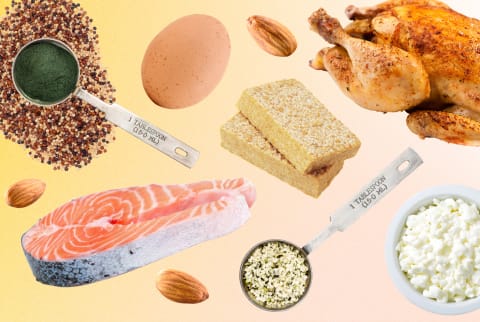According to naturopathic physician and registered dietitian Jaime Schehr, N.D., R.D., “Dietary proteins are made up of amino acids, which are largely responsible for both muscle building and muscle repair,” making it especially important to eat after exercising. While the actual definition of “high protein” can differ based on labeling, Cording says, “In general, for something to be high protein, a serving needs to provide at least 20% of the recommended daily intake for protein. In the U.S. that’s about 56 grams per day.” While that definition can be a helpful tool in the grocery store, registered dietitian Molly Knudsen, M.S., RDN, says you can also take a more general approach. “Instead of focusing on the grams of protein in each food,” she explains, “focus more on the quality and serving size of the food. And try to eat protein at every meal and snack to increase satiety.” To spare you from mulling over nutrition labels, these are 15 of the most high-protein foods, according to the U.S. Department of Agriculture (USDA) food charts1. Whether roasted, poached, or grilled, this versatile and popular poultry is high in protein. One grilled breast contains about 59 grams of protein. Turkey breast contains two essential amino acids, histidine and tryptophan, which help make up the building blocks of protein. Just 3 ounces of turkey breast contains more than 25 grams of protein. When eating red meat, leaner options tend to be lower in cholesterol and saturated fats. According to the USDA, 4 ounces of lean beef contains 24 grams of protein. Along with being good sources of omega-3 fatty acids, nearly all fish are high in protein (even canned fish). In fact, canned tuna contains 22 grams of protein, while one 3.5-ounce tuna steak contains 40 grams. If you’re not eating tuna and sticking with SMASH, salmon is still a quality source of protein with 28 grams per 5 ounces. While eggs are famously a breakfast food, you can also enjoy them in a grain bowl or at dinner over crispy rice. The versatile food (hard-boiled, soft-boiled, scrambled, poached, fried—the options are endless) contains 6 grams of protein per egg, so enjoy two at a time for good measure. Cottage cheese might not look, or frankly sound, very appealing, but it’s actually rather mild in flavor. Cording says cottage cheese makes for a “great toast topper instead of cream cheese or butter and also adds staying power to a smoothie or oatmeal.” One bowl contains 13 grams of protein. Collagen is a protein found in animals, including humans. In fact, functional medicine doctor Robert Rountree, M.D., explains “Seventy to 85% of our skin is collagen, and we lose it as we age.” Supplementing with grass-fed collagen powder is one way to increase that protein intake as it naturally begins to decline. The values will vary based on brand, but 2 tablespoons of mindbodygreen’s grass-fed collagen+ contain 15 grams of protein. While we love the comedian’s witty answer, here are eight more potential responses. Chickpeas are a versatile source of fiber, and half of a cup provides 10 grams of protein. When dried, the beans can be ground down into chickpea flour and used to make pasta, which, compared to wheat pasta, Cording says “is one way to integrate more protein into the meal.” There are also plenty of ways to enjoy chickpeas straight from a can. One cup of cooked black beans contains about 15 grams of protein and 15 grams of fiber, which means they’ll keep you fuller longer. Bonus: They’re also loaded with 26% of your daily intake of zinc. Lentils come in several varieties: green, red, and black beluga, to name a few. They are part of the legume family, so it’s no surprise lentils are loaded with nutrients. One cup of cooked lentils contains 6.6 mg of iron, 15 grams of fiber, and 18 grams of protein. Hemp seeds are a complete source of protein, meaning they contain all nine essential amino acids. You can blend them into soups to keep you fuller longer, sprinkle them on top of smoothie bowls, or toss them in granola. About 2 to 3 tablespoons of hemp seeds contain 11 grams of protein and about 15 grams of healthy fats. Lupini beans, also called lupin beans, are popular among people following vegan keto diets because they contain zero net carbs and are high in protein (11 grams of protein per 44 beans). Studies have also shown that a diet rich in fiber and protein from lupini beans might decrease cardiovascular and metabolic risks2. A bowl of warm oatmeal provides more benefits than just comfort. Oats are high in dietary fibers, vitamin E, and lipids3 to promote energy. One cup of oats contains 10 grams of protein. Pistachios, like hemp seeds, are a complete source of protein. Eating half a cup of these green nuts gives you 12 grams of protein. If you’re looking for more ways to add pistachios to your diet, use them to add some crunch to your dishes, blend them into pistachio butter, or eat them as a snack. Spirulina is a blue-green algae that provides antioxidants, vitamins, minerals, and other nutrients to your diet, usually in the form of a powder. It’s commonly considered a good source of plant-based protein, as it’s made up of 55 and 70% of the nutrient, equaling about 64 grams per cup. A typical serving size (1 tablespoon) provides a little more than 4 grams to your diet.



